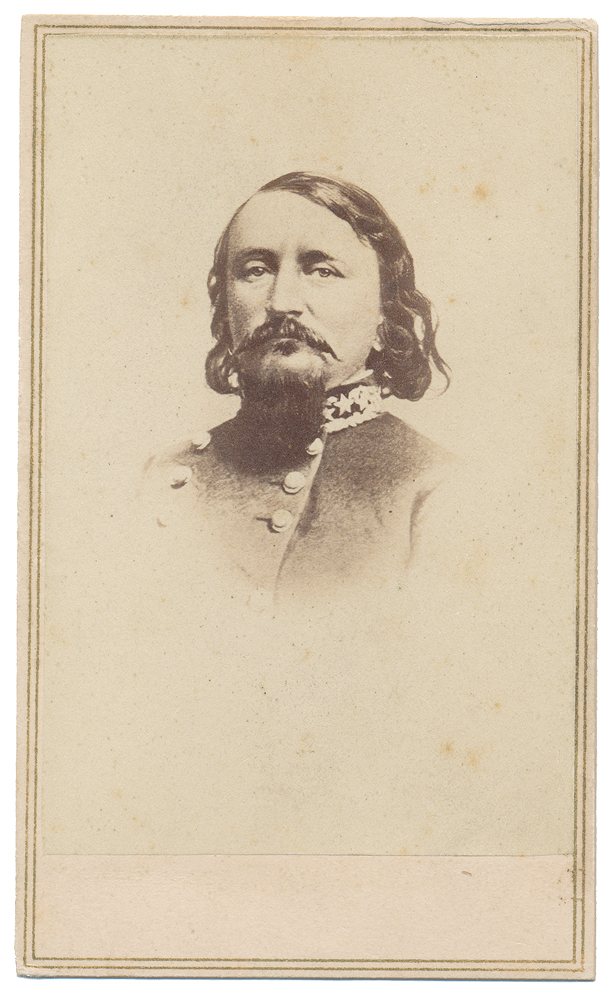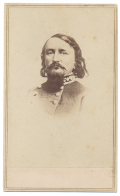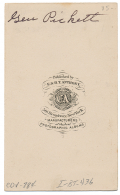site search
online catalog
BUST VIEW CDV OF GENERAL GEORGE E. PICKETT

$475.00 SOLD
Quantity Available: None
Item Code: 1138-436
Chest-up vignette view of Pickett in Confederate uniform.
Contrast and clarity are very good as is the paper and mount.
Reverse has a photographer’s imprint for E. & H. T. ANTHONY… NEW YORK. Reverse also has “GEN. PICKETT” in bold old ink with collector information in pencil at bottom.
From the collection of the late William A. Turner.
George Edward Pickett was born at Richmond, Va., January 25, 1825. He was graduated at the United States military academy in the class of 1846.
Going into the war with Mexico he was promoted second lieutenant, 2nd Infantry; was transferred to the 7th and finally to the 8th Infantry, and participating in all the important engagements of Scott's army, was brevetted first lieutenant for gallantry at Contreras and Churubusco; earned the brevet of captain at Chapultepec, and finally took part in the capture of the Mexican capital.
He subsequently served with the 8th Infantry on frontier duty in Texas until 1855, when he was promoted captain 9th Infantry, and given a year's assignment to Fortress Monroe. He was afterward on duty in Washington territory, until the spring of 1861.
In 1856 he occupied San Juan island with sixty men, and forbade the landing of British troops, winning the thanks of the territorial legislature for his gallant and firm discharge of duty, and the commendation of General Harney for "cool judgment, ability and gallantry." His loyalty and firmness saved the rights of the United States until the title to the island was confirmed by international arbitration, and "Fort Pickett" guarded one end of the island until the British finally retired.
His first commission in the Confederate service was as major of artillery, regular army. On July 23, 1861, as colonel in the provisional army, he was assigned to temporary command on the lower Rappahannock, with headquarters at Fredericksburg, and on February 28, 1862, being promoted to brigadier-general, he was ordered to report to General Longstreet.
Commanding a brigade of Longstreet's corps, he won commendation for "using his forces with great effect, ability and his usual gallantry, " at Williamsburg. On the second day of the battle of Seven Pines he was particularly distinguished for his good generalship during an attack by Hooker's command.
An order to withdraw was received, which was obeyed by the other brigade commanders after the repulse of the first attack; but "Pickett, the true soldier," as Longstreet writes, "knowing that the order was not intended for such an emergency, stood and resisted the attack," holding his ground against odds of ten to one for several hours longer.
At Gaines' Mill, fighting on the right with Longstreet, his brigade broke Porter's line just west of the Watts house, attacking with such vigor as almost to gain possession of the Federal reserve artillery. In this assault Pickett fell severely wounded.
In October, 1862, Pickett was promoted to major-general and assigned to a division of Longstreet's corps, composed of his old brigade under Garnett, and the brigades of Armistead, Kemper and Corse, all Virginians, and Micah Jenkins' South Carolina brigade.
He held the center of the line at Fredericksburg, and after that battle was sent with his division to Richmond, which was supposed to be threatened by the Federal movements. He was reinforced by Hood's division, and General Longstreet, in command, operated against Suffolk.
Pickett went into the Gettysburg campaign with three brigades, Garnett's, Kemper's and Armistead's, and Dearing's artillery. He reached the battlefield with his men on the forenoon of the third day of battle, and was selected to make the attack upon the Federal center on Cemetery Hill, Heth's division under Pettigrew to form the left of the line, which should be supported by Pender's division under Trimble.
The story of the charge has been often eloquently related and need not be repeated here except to say the attack failed with heavy losses to Pickett’s Division. Pickett himself was unhurt.
In September, 1863, Pickett was assigned to command of the department of North Carolina, embracing Petersburg and Southern Virginia. He made a demonstration against New Bern in the latter part of January, 1864. In May he joined Lee on the North Anna, and from that time commanded his old division, Armistead's, Pickett's, Corse's and Kemper's brigades, now under Barton, Hunton, Corse and Terry, until the close of hostilities.
On June 16th, Lee arrived at Drewry's Bluff with Pickett's division, and witnessed the recapture of the Confederate lines from Butler.
Pickett remained before Bermuda Hundred until March, 1865, when he was sent to Lynchburg to oppose Sheridan's raid, and then marched with Longstreet north of Richmond in an attempt to intercept the Federal cavalryman, whom he finally met on March 31st and April 1st at Dinwiddie Court House and Five Forks.
General Pickett had received orders from Robert E. Lee to, with the Cavalry divisions of Major Generals William Henry Fitzhugh Lee and Thomas L. Rosser, hold the vital railroad crossing at Five Forks at all costs. On April 1, 1865 their troops were attacked by a combined force under Major General Philip Henry Sheridan, which consisted of the 5th Corps of the Army of the Potomac, commanded by Major General Gouverneur K. Warren, and the Cavalry Corps of the Army, commanded by Brigadier General Wesley Merritt. Pickett, W.H.L. Lee, and Rosser were located behind the lines of their troops at the time of the attack, enjoying a shad bake while failing to inform their subordinate officers of their location. Meanwhile, Warren's troops overwhelmed Pickett's left flank, and the Cavalry troops pinned the Confederates down elsewhere. By the time the Confederate commanders realized the catastrophe, it was too late to prevent the defeat. The result of the battle, as well as that of the Third Battle of Petersburg the following day, forced Lee to abandon his entrenchments at Petersburg, leading to the capture of Richmond and surrender of his army on April 9
Pickett marched with his division from Petersburg, escaped from the disaster at Rice's Station with 600 men of his splendid division, and finally was surrendered April 9, 1865, with the last of the army of Northern Virginia.
Subsequently he engaged in business at Richmond, but did not survive the first decade following the war, dying at Norfolk, July 30, 1875. He is buried in Richmond’s Hollywood Cemetery. [ad] [ph:L]
~~~~~~~~~~~~~~~~~~~~~~~~~~~~~~~~~~~
THIS ITEM, AS WITH ALL OTHER ITEMS AVAILABLE ON OUR WEB SITE,
MAY BE PURCHASED THROUGH OUR LAYAWAY PROGRAM.
CLICK HERE FOR OUR POLICIES AND TERMS.
THANK YOU!
Inquire About BUST VIEW CDV OF GENERAL GEORGE E. PICKETT
For inquiries, please email us at [email protected]
Most Popular
Historical Firearms Stolen From The National Civil War Museum In Harrisburg, Pa »
Theft From Gravesite Of Gen. John Reynolds »
Cavalry Carbine Sling Swivel »
Fine Condition Brass Infantry Bugle Insignia »
featured item
SELMA ARSENAL WRAPPER AND ENFIELD CARTRIDGES
Included in a wood display case is a cartridge wrapper from Selma Arsenal dated July 1864, seven complete cartridges, and a pack of percussion caps. The cartridges and caps came out of this wrapper. An excavated Enfield bullet is also included,… (1000-743). Learn More »




